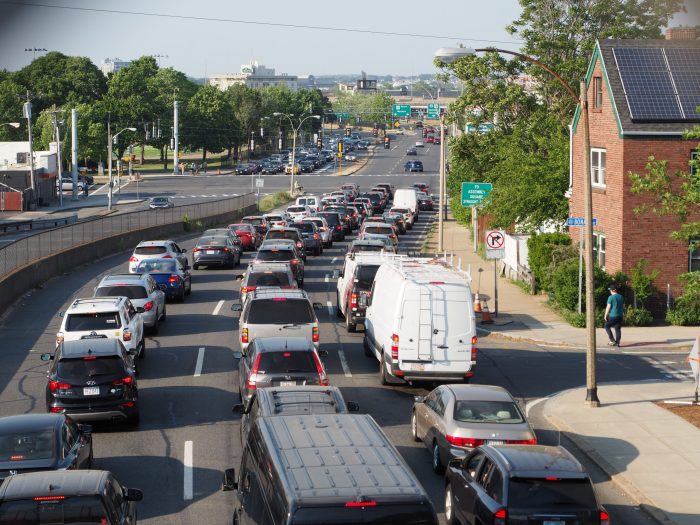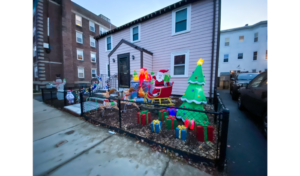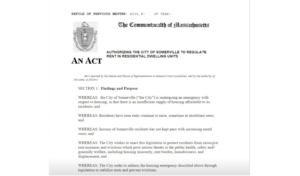This past June, MassDOT announced that it would address safety concerns connected to East Somerville’s highways
The Somerville Wire recently received a Kozik Environmental Justice Reporting Grant, through the National Press Foundation and the National Press Club Journalism Institute. This article is the first in a series about how roadways like I-93 and others in East Somerville have posed health risks to residents, many of whom are immigrants, people of color, or working-class individuals. Not only do highways present barriers, dividing East Somerville from other neighborhoods, but residents face the prevalent threat of air and noise pollution. Advocates have said that this is not an accident. Here is a look at how recent improvements and community responses have played out.
(Somerville Wire) – On June 30, the Massachusetts Department of Transportation held a virtual public meeting, where they outlined improvements that they would be making to an area near the I-93 viaduct, above the junction of the Fellsway, McGrath Highway, and Mystic Avenue in East Somerville. These changes were planned largely in response to intense, community pressure. Prior to this announcement from MassDOT, political leaders like Rep. Mike Connolly were alarmed by MassDOT’s proposed viaduct project—which he had first heard about in April 2021. Activists, community members, and representatives were concerned that the project would prioritize the “safety of the steel” over the public health needs of East Somerville residents, who have been underserved in so many ways. Connolly said that he is encouraged by MassDOT’s news of improvements.
“I think we’ve reached a much better place … we’re getting a lot more in the near term and ultimately, we’re anticipating, getting even more in the longer term,” said Connolly. “Previously, it had been stated from MassDOT that there would be a federally funded, significant Route 38/28 intersection road safety [plan] that would be happening in 2022. Then when the I-93 viaduct project was brought forward, it had been said, ‘well, that thing that we talked about, that’s not happening until 2023.’ It appears, as a result of our real, focused effort here, what’s happening now is that we’re going to be seeing a lot more work done now, in 2021. There’s potential for additional work to happen in 2022. And the scope of that larger federal project that we had been working on and advocating for, when that does happen, that’s going to be bigger, as well.”
Improvements that MassDOT introduced at the June 30 meeting include addressing environmental concerns, eliminating detours, and responding to safety concerns. MassDOT is also undertaking a study with a focus on design feasibility of sound walls on I-93. Plans also involve creating pedestrian crossing islands, raised sidewalks, and crosswalk visibility enhancements. While many see the improvements as a step in the right direction, local grassroots activist Wig Zamore—who does environmental health research—said that the air pollution problem and transportation noise issues are not being mitigated enough.
“It’s much easier to focus environmental justice impacts on acute impacts than on chronic impacts,” said Zamore, “and the chronic impacts vastly outnumber and outweigh the acute impacts, with regard to premature mortality and other health effects. That’s always an issue. While I appreciate that it was some acute episodes that really triggered some of the emotional involvement in the highway fix-ups, the much bigger issue is the ultrafine particles, and transportation noise will also rise up.” He added, “The health and community impacts of the long term air pollution in the corridor are orders of magnitude larger than what was discussed, during this recent episode. I’ve been quoted as saying there have likely been 5,000 premature deaths since the opening of I-93 in Somerville, and I think that’s probably the case.”
Ellin Reisner, president of the Somerville Transportation Equity Partnership, said that she is appreciative of the improvements but would like to hear more about the study that MassDOT is putting together, which MassDOT has said will take three months to complete. According to MassDOT Communications Director Kristen Pennucci, the study will “evaluate potential abatement measurements to mitigate air and noise pollution in the East Somerville. The study will focus on the neighborhoods along the I-93 corridor that travels through Somerville, such as the Winter Hill and State Avenue area.” Reisner said that she wishes MassDOT had been more open and communicative with local people about this project.
“I’m glad that they’ve agreed to do this study and have to wait and see what they come up with,” said Reisner. “Studies take a long time, and we’d like to see something done. I want to see what they’re going to do.” She added, “They have not reported back to the community about this study and when it’s going to be conducted. Given all the issues that are going on, it would be better to have more communication and more frequent communication.”
MassDOT was able to clarify its timeline, regarding the improvements. Since the June 30 meeting, the Blakely Avenue intersection was upgraded with a new pedestrian crossing signal, paving, and markings, which include travel lane markings and crosswalks. From now until November, the Viaduct Preservation Project will continue the process of finding a contractor. Construction is anticipated to begin in March 2022. For the fall of this year, MassDOT will continue to work on safety improvements.
“The next phase of safety improvements focuses on the design and construction of four raised crosswalks—three at the Kensington Connector where it crosses Route 38 (Mystic Avenue) just south of Route 28 and a fourth at the intersection for right turns from Route 28, northbound to Route 38 southbound. With the design at the 50 percent stage, construction is expected to start later this year,” according to Kristen Pennucci. “The design of additional safety elements, mainly accessibility improvements, remains a priority and is progressing along with the raised crosswalks but needs additional time because of the challenges the current layout presents. Once the design is completed the work will be scheduled.”
Connolly said that he sees the problems relating to the highways in East Somerville as an environmental justice issue. East Somerville has a population of 10,000 people, many of whom are people of color or low-income residents. The health impact that the highways have had on the neighborhood’s residents is an example of how systemic racism and nativism was ingrained in mid-20th century urban planning of the type that led the highways in question to be routed through poor communities.
“It’s almost like a chicken and an egg problem,” said Connolly. “They have to put the highway somewhere. They were never going to put a highway through West Cambridge, on Brattle Street. They’re going to put the highway through whichever neighborhood has the least political power to organize opposition and defeat it. The highways got put typically in places that were the least empowered, and then, that perpetuates. Now that the highway is there, you’re perpetuating those injustices.” He added, “It is totally the case that Somerville has essentially paid a price to serve everyone else’s transit needs.”
An earlier form of this article stated that MassDOT had plans to build sound walls in East Somerville, but they are just conducting a study with a focus on design feasibility of sound walls on I-93.
This article is syndicated by the Somerville Wire municipal news service of the Somerville News Garden project of the Boston Institute for Nonprofit Journalism.
All Somerville Wire articles may be republished by community news outlets free of charge with permission and by larger commercial news outlets for a fee. Republication requests and all other inquiries should be directed to somervillewire@binjonline.org.
SUBSCRIBE TO THE FREE SOMERVILLE WIRE EMAIL NEWSLETTER: https://eepurl.com/hpBYPv
Check out all our social media here: https://linktr.ee/SomervilleWire.
Shira Laucharoen is assistant director of the Boston Institute for Nonprofit Journalism and assistant editor and staff reporter of the Somerville Wire.





